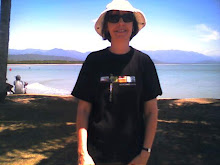18. Read about the Library 2.0 movement and explore new developments in Library related interfaces such as Encore and the new Ebscohost 2.0 interface
Have read a few things about library web 2.0. Sound quality with some of the interviews with Libray 2.0 Gang was pretty crappy, even with the speaker volume turned up.
The wikipedia article on library 2.0 was interesting.
http://en.wikipedia.org/wiki/Library_2.0
I think there are still issues around access to technology, privacy and security. While it's great to be involved, there are still some issues that are a concern to some people. Then again, maybe I'm just paranoid!
Check out what Steve Lawson collected, a whole lot of links to blogs about these very issues.
http://stevelawson.name/seealso/archives/2006/05/a_library_20_sk.html
Another interesting read is the "Library 2.0 Reading List" originally created for the ALA Library 2.0/Library Futures online course.
http://www.squidoo.com/library20
See part 5 below :
5 Suggestions for Upgrading to Library 2.0 (or Some Easy Steps to Get Started...Really)
Michael Stephens on 5 things libraries can do to get started on a 2.0 path:
Start a library blog
Create an Emerging Technology Committee
Train staff to use an RSS aggregator
Experiment and use 2.0 Tools
Implement IM reference
Visited Eltham library a few weeks ago (Yarra Plenty network) and saw how the RFID system works. Patrons stack their own books in a pile at the checkout points and swipe a library card and the LMS checks out the whole stack of books. Clients can also check their accounts and look for overdues etc. Not sure if all this is strictly library web 2.0, but the RFID chips in books allow clients to have more interaction with the check out and account checking processes.
Have read the article on Encore, and I remember the "Encore intro" which was part of the 2007 AIUG (Canberra) presentation by Bill Easton which had a good demonstration of relevancy ranking, faceted navigation, popular choices and the "did you mean" feature.
file:///C:/Documents%20and%20Settings/Owner/Local%20Settings/Temporary%20Internet%20Files/Content.IE5/X7STHNF2/AIUG_corporate_update_2007[1].ppt#729,1,
Now, back to the Encore article,
I think it's clever to use features that people are pretty familiar with, for example, the Encore search box is pretty simple and uncluttered, much like the Google search box, and the "relevancy ranking" strength is represented by "bars" similar to a display on a mobile phone that represents the strength of the communication signal. Even though the default search order is by relevancy rank, it is good that clients can change the sort order to title or date.
Tag clouds seem to be the flavour of the month in web 2.0, but the use of different font sizes in Encore to represent the level of popularity or impotance, can take some time to get used to. Sometimes the font size can be confusing and can make the screen look a bit "busy".
http://0-web.ebscohost.com.library.vu.edu.au/ehost/pdf?vid=2&hid=117&sid=38175e58-fb69-4ae6-bf00-9aeb1ab8a732%40sessionmgr107
The EBSCOhost 2.0 article was interesting. It has a similar concept to "relevance ranking" as Encore, which is "Preferences link", which allows users control over the look and feel of the Result List, and lets users save those preferences in a "My EBSCOhost" folder for use in future sessions. A future enhancement will make it possible for EBSCOhost users to share folders.
http://www.researchinformation.info/products/product_details.php?product_id=138
Thursday, October 9, 2008
Subscribe to:
Post Comments (Atom)

No comments:
Post a Comment